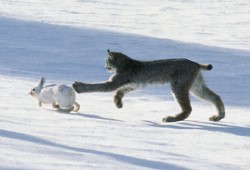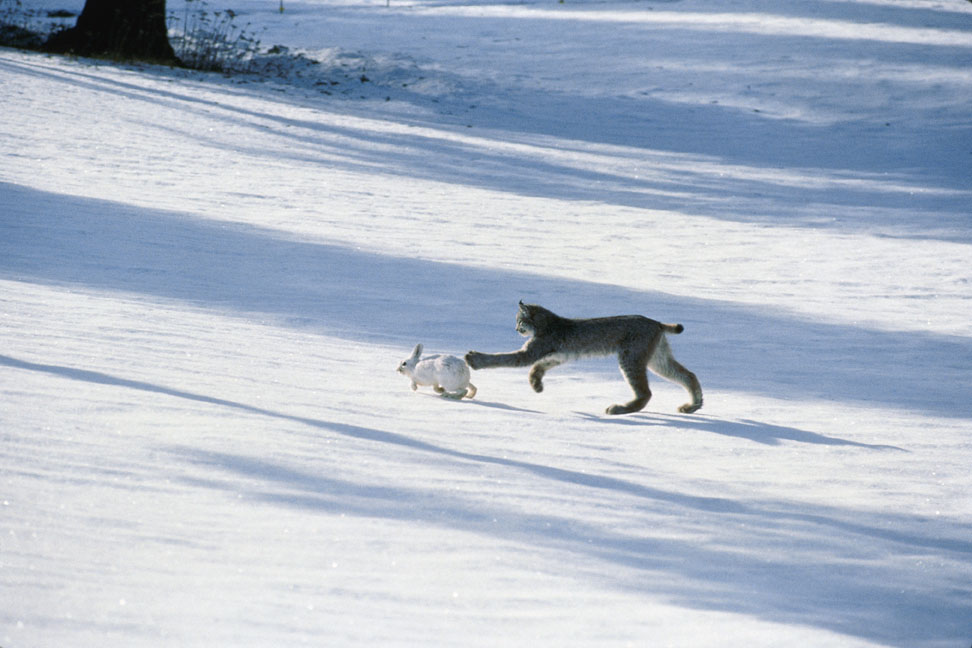Staying Alive
Mathematical models often predict that predators will hunt their prey to extinction or that predators will starve to extinction when the prey population drops. Real species are far more stable, in part because the animals live in many spatially separated areas that can replenish one another through migration. But this result has been difficult to recreate in mathematical models, and researchers haven’t understood exactly which conditions prevent extinction. In the 2 March Physical Review Letters, a team describes a stable model that includes migration and determines the precise mechanism that prevents extinction. The study could be helpful for designing conservation strategies and in medicine, the researchers say.
When the number of prey grows, the predators flourish too. But eventually there are too many predators and the prey population drops. Deprived of food, the predator population drops a bit later. In the 1920s and 30s, mathematicians came up with differential equations to model these oscillations. But as their creators recognized, the solutions aren’t stable. Adding some random fluctuations to represent external effects–such as disease, competition with other species, or changes in the weather–can make the model populations swing more and more to extremes, until one species goes extinct.
More recently researchers have also used the alternative approach of computer simulations, where they start with rules for behaviors of individual animals and then “watch” the virtual populations change over time. These computational “experiments” have suggested that populations stabilize if the animals inhabit several regions, with some migration between them. That way, the regional populations can oscillate and sometimes go extinct, but the overall populations of both predator and prey can persist. Lab experiments, with bacteria as prey and viruses as predators, for example, have also found that multiple regions help stabilize the populations. But the precise relationships that prevent extinctions haven’t been clear.
Now a rigorous mathematical solution to this problem comes from a team led by Nadav Shnerb of Bar-Ilan University in Israel. Starting from the classic differential equations for predator-prey systems, they modeled a pair of regions, each with a predator and prey species, and allowed some migration between them.
The model was designed to tease out the precise relationships that lead to stable populations. Shnerb and colleagues found that the key property is to have the frequency of the oscillations dependent on their amplitude. This has a straightforward interpretation in real life, backed up by observations: when populations are small, they tend to grow or shrink slowly, whereas when they’re large, the population size can change much more quickly. With this key property, adding in some random population fluctuations–the “noise” of the real world–kept the regions’ population oscillations out of sync, so that the overall population of both species never died out. The study affirms an old solution ecologists had intuited–that desynchronization between regions, coupled with migration between them, could create stability overall. But the new results put that idea on firm mathematical footing.
Shnerb says that the results could be useful for improving models of threatened species living in fragmented habitats. They could also find use in medicine, aiding new antibacterial therapies that use bacteria-killing viruses. In this case, scientists could calculate the conditions that would make the system unstable, ensuring that the bacteria would all die off.
In many cases, “natural populations are more stable than [earlier] models would suggest,” says Vincent Jansen, a mathematical biologist at the Royal Holloway University of London, in Surrey, England. “What this paper shows is that if you look at it in an appropriate way, you can see that spatial interactions would stabilize things.” He adds, “I think it goes a long way to explain the behavior of populations in nature.”
–Mason Inman
Mason Inman is a freelance science writer in San Francisco.





